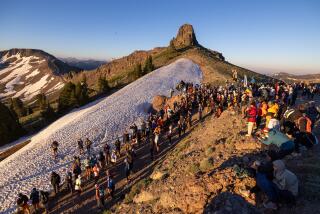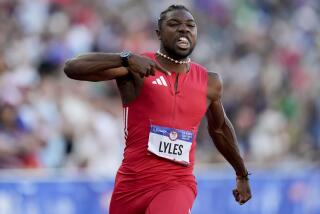Image Busters
- Share via
Mitch Potter and Adam Steele run to win races and tear down stereotypes.
They are well aware of what they’re not supposed to be able to do.
Cold-weather northern states like Minnesota, don’t you know, rarely produce international-quality quarter-milers.
And track and field athletes who are good in high school don’t often become great in college.
And, of course, the kicker: White men just don’t do well anymore in the speed events.
“I love the fact that some people think white people can’t run fast,” said Potter, who recently won the 400-meter event at the Pan American Games. “That’s completely not true.”
He is, after all, proof positive. And so is Steele, a teammate from the University of Minnesota who won the NCAA championship in the same event in June. Potter was third in the NCAA final. Steele was fourth in the Pan Am Games.
Steele’s 44.57-second clocking in the NCAA final is tied for the fifth-fastest time in the world this year. Potter’s 44.58 best ranks seventh.
They are in the eight-person pool from which the U.S. will draw its men’s 1,600-meter relay team in the world championships at Paris. The heats of the 1,600 relay will be held Saturday with the final Sunday.
Steele is the first white athlete to win the men’s 400 meters or 440 yards in the NCAA championships since 1964 and no white athlete has represented the U.S. in the 400 in the Olympic Games or world championships since the 1964 Games at Tokyo. But he doesn’t view his ethnicity as a hindrance.
“I don’t remember ever thinking, ‘I’m white so I can’t run with these guys,’ ” he said. “In Minnesota, I ran against a lot of Caucasian athletes in high school. But I never gave it much thought when I got to college. My attitude in high school was, ‘If you run fast, you can win races.’ And that’s still my attitude.”
Antonio Pettigrew, a member of USA Track & Field’s board of directors and an African American ranked among the top 10 quarter-milers in the world 10 times during a career that ended last year, never felt as if he had an advantage over his white counterparts. But the 1991 world champion said many white athletes in the U.S. have bought into the stereotype that says white men can’t sprint.
“Germany has had some great 400 runners over the years and they were white,” Pettigrew said. “So I never thought race made a difference.... But I think there were times when [white athletes] just didn’t try to compete in the sprints. They were intimidated and just competed in certain events.”
Potter expressed similar sentiment.
“If anything, it’s white people letting that type of thinking go to their heads,” he said. “I look at [an African American 400 runner] like Calvin Harrison as just like me. He might be better than me right now, but that just means I need to do something different in training to be as good as him. I never look at it like I can’t be as good as him because of the color of my skin.”
A week after the NCAA championships, Potter finished fifth and Steele sixth in the USATF championships to earn spots in the national 1,600 relay pool for the world championships.
“It just goes to show that you don’t have to be from California or Texas or one of those warm southern states to run a good 400,” Steele said. “You can be from the north and run well too.”
Neither Steele nor Potter were high school superstars. Steele won Minnesota state Class AA titles in the 400 and 800 and ran a leg on the victorious 3,200 relay team as a senior at Eden Prairie High in 1999, but his best time of 47.66 in the 400 ranked him 34th on the U.S. high school list that year.
Potter won state Class A titles in the 110 high hurdles and 300 intermediate hurdles during his senior season at St. Michael-Albertville in 1999, but his best of 37.39 in the latter event ranked 27th on the national list.
“One thing you have to be aware of when you recruit a kid from a northern state is that they don’t get that many opportunities to run fast because of the [cold] weather,” Minnesota Coach Phil Lundin said. “Their outdoor season doesn’t start until April and even then, the weather can be very unpredictable. It’s not uncommon for it to snow in April.... Someone who runs 47-point [in the 400] in a northern state has more upside than a kid who runs a similar time elsewhere.”
Neither Steele nor Potter had instant success at Minnesota. Injuries forced both to sit out the 2000 track season, but the outgoing athletes became best friends while spending time in the trainer’s room.
Steele lowered his best in the 400 to 46.93 in 2001 and won the Big Ten Conference title last year, but his best of 46.15 just missed qualifying him for the NCAA and USATF championships.
Potter, who excelled in track, football and wrestling in high school, finished seventh in the 400 in the 2001 NCAA indoor championships and ran a career-best 45.40 early in the outdoor season. But injuries hampered him for the rest of that season and forced him to sit out the second half of the outdoor season last year.
A training regimen that includes substantial amounts of hill running has contributed to their success this year.
The Minnesotans’ 1-3 finish in the NCAA championships was the best by a school in the men’s 400 since UCLA’s Danny Everett and Steve Lewis finished first and second in 1988 before finishing third and first in the Olympic Games at Seoul that summer.
“Ever since the NCAA championships, people have been asking, ‘Are these guys a flash in the pan or the real deal?’ ” Lundin said. “But there is no doubt in my mind that they’re going to be factors in the 400 for a few years to come. They’re both very tough, competitive guys who work hard.”
And can run with anyone.
More to Read
Go beyond the scoreboard
Get the latest on L.A.'s teams in the daily Sports Report newsletter.
You may occasionally receive promotional content from the Los Angeles Times.










